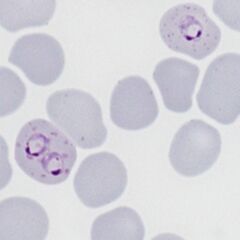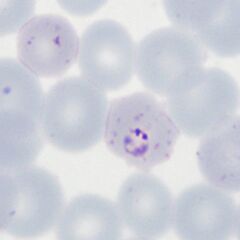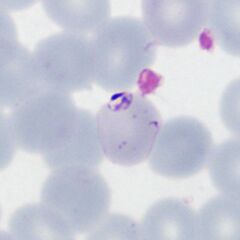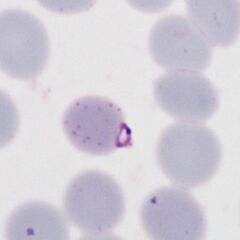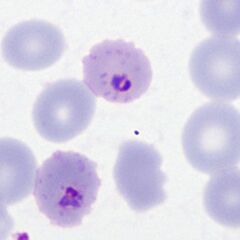P.falciparum late trophozoites gallery: Difference between revisions
From haematologyetc.co.uk
No edit summary |
No edit summary |
||
| Line 17: | Line 17: | ||
<gallery mode="traditional" widths=240px heights=240px> | <gallery mode="traditional" widths=240px heights=240px> | ||
File:PFLT1p.jpg|<span style="font-size:80%">'''Late rings''' Two cells both with typical dots: multiply infected and double dot forms</span>|link={{filepath:PFLT1p.jpg}} | File:PFLT1p.jpg|<span style="font-size:80%">'''Late rings''' Two cells both with typical dots: multiply infected and double dot forms</span>|link={{filepath:PFLT1p.jpg}} | ||
File:PFLT2p.jpg|<span style="font-size:80%">'''Double chromatin dot form''' | File:PFLT2p.jpg|<span style="font-size:80%">'''Double chromatin dot form''' also Maurers dost and clefts, slight crenation and lost pallor</span>|link={{filepath:PFLT2p.jpg}} | ||
File:PFLT3p.jpg|<span style="font-size:80%">'''Accolé form''': The arrowed form is closely associated with the red cell membrane</span>|link={{filepath:PFLT3p.jpg}} | File:PFLT3p.jpg|<span style="font-size:80%">'''Accolé form''': The arrowed form is closely associated with the red cell membrane</span>|link={{filepath:PFLT3p.jpg}} | ||
File:PFLT4p.jpg|<span style="font-size:80%">'''Multiple parasites''' Two parasites within a single red cells (arrowed)</span>|link={{filepath:PFLT4p.jpg}} | File:PFLT4p.jpg|<span style="font-size:80%">'''Multiple parasites''' Two parasites within a single red cells (arrowed)</span>|link={{filepath:PFLT4p.jpg}} | ||
File:PFLT5p.jpg|<span style="font-size:80%">'''High parasitaemia''' Most of the typical early trophozoite ''P.falciparum'' forms are present</span>|link={{filepath:PFLT5p.jpg}} | File:PFLT5p.jpg|<span style="font-size:80%">'''High parasitaemia''' Most of the typical early trophozoite ''P.falciparum'' forms are present</span>|link={{filepath:PFLT5p.jpg}} | ||
</gallery>" | </gallery>" | ||
Revision as of 00:25, 21 March 2024
Navigation
Go Back
|
